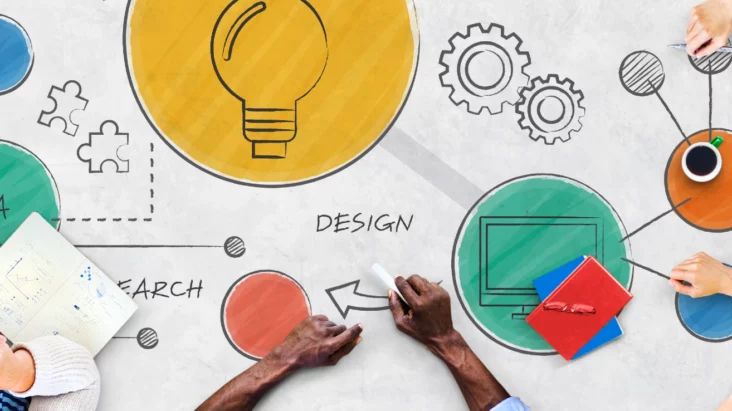In brief:
The definition of product management is always up for debate, but at its core, the process is all about creating and bringing products to market. It can be a complex job, but you can succeed with the right tools in your toolkit. This comprehensive guide will break down everything you need to know about product management – from ideation and requirements gathering to design and testing. So whether you’re just starting or looking to develop a more well-rounded product management function, read on!
Introduction
This comprehensive guide will explore what product management entails and how you can leverage it for your business. We’ll discuss the different aspects of product management, such as ideation, the product vision and navigating the product development process. By understanding these concepts, you’ll be able to create successful products in your market!
In this blog we will be discussing the below:
What is product management, and what does it involve?
Product management is creating and bringing a new product to market. It involves everything from research and development to marketing and sales. The goal of product management is to ensure that the product meets the needs of consumers and that it can compete successfully against other products in the marketplace. The product management team must have a strong understanding of both the market and the product. They must also be able to communicate with both customers and employees effectively. Product management can ensure that the product meets all expectations and is launched successfully by working closely with all stakeholders.
Below we’ll look at three main areas that you should focus on when building your product management function.
Product strategy
Product strategy is all about making sure that the product is developed to meet the needs of the market and take into account the competition. It’s a process that starts with understanding the customer and ends with delivering a product that meets their needs. In between, there are a lot of decisions to be made about things like features, price, and distribution. And product strategy is what helps guide those decisions. Without a product strategy, it would be very easy to get lost in the details and end up with a product that doesn’t do anything well. But with a product strategy, you can be confident that you’re making decisions that will help your product succeed.
Product design
Product design is more than just making products look pretty – it’s also about making sure they work well and are easy to use. Good design makes products easier to use and helps them stand out from the competition. It can also be a significant factor in success or failure. The best product designs take into account the customer’s needs and are easy to use. Poor product design can lead to customer frustration, high return rates or cancellations, product recalls and even service closure. In today’s competitive market, product design is essential for ensuring that your product is successful. By taking the time to create a well-designed product, you can ensure that your product will be well-received by the market.
Product development
Product development is the process of taking a product from concept to launch. It’s a complex process that involves many different steps, and it can take a long time to complete. There are many things that need to be considered during the development process, such as software engineering, user testing and final launch. And each step needs to be completed before moving on to the next one. The product development process is essential for ensuring that a product is high quality and meets customers’ needs. By carefully developing a product, businesses can avoid costly mistakes and create a product that is sure to be successful.
The product management process - from ideation to launch
Different frameworks help define specific aspects of the product management process, like SCRUM, the Scaled Agile Framework® (SAFe), Spotify Squads and Google’s HEART. In a future post, I’ll look at these different frameworks in more detail, but for now, at its core, we can still break down the product management process into six steps:
Ideation (Idea creation)
Ideation is a crucial step in the product development process, and we should not take it lightly. The product manager and development team must put themselves in the customer’s shoes and think about what they need and want. They must also be aware of market trends and what competitors are doing. Only by taking all of these factors into consideration can they develop products that will meet the needs of their target customers.
Requirements gathering
After getting your product idea approved, the next step is gathering requirements from stakeholders and team members. This is important to build out the features and functionality of your product. You will need to clearly understand what users want and need to create a successful product. We can gather requirements through various methods, such as interviews, surveys, focus groups, and user testing.
It is essential to get input from as many people as possible to get a well-rounded perspective. Once you have gathered all the requirements, you can start creating a product specification document; in agile software development, these are known as user stories and will guide the development process.
Product design
The design phase is one of the most critical steps in creating a new product. This is where the product takes shape and begins to come to life. The product manager works closely with designers to create a prototype that meets all the requirements during this phase. This can be challenging, as there are often many different ideas and opinions about the product’s appearance and function. However, by collaborating closely and efficiently, the team can create a final product that everyone is happy with.
Product development
Once the design is finalised, it’s time to start development. This is where the product manager and development team must work together closely to ensure that everything goes according to plan. The product manager will need to provide regular updates on the product’s status and ensure that all stakeholders are kept in the loop. Any changes or updates to the requirements must be communicated to the development team immediately to make the necessary adjustments.
User testing
When a new product is being developed, it’s essential to ensure that it will work as intended before it goes to market. That’s where testing comes in. By putting the product through its paces in a simulated environment, developers can catch any errors and make corrections before it’s too late. This can save a lot of time and money down the line, and it helps to ensure that the final product is of the highest quality. In short, testing is an essential step in the development process, and it should never be skipped.
The agile development methodology has changed the landscape of software design, development and testing. In the past, the software development process was a linear one where designs were created first, followed by the development, then testing. However, with agile, the design, development and testing phases are all interwoven. This allows for a more iterative and flexible approach to software development, where changes can be made quickly and easily. As a result, agile has become the preferred methodology for many software development projects.
Product launch
Launching a new product can be a daunting task, but with careful planning and execution, it can be a successful endeavour. The first step is to ensure that the product is ready for launch. This means that it has been tested and approved by the appropriate authorities. Once this is done, the product development team works with marketing and sales to develop a launch plan. This plan should take into account the needs of the target market, the competitive landscape, and the objectives of the launch. With a solid plan in place, the product development team can then work to ensure that the product is successfully launched into the market.
Product management training course starting soon
ONLINE TRAINING
If you’re looking to learn more about product management, be sure to check out our upcoming product management training course. This two-day course will cover all the essential aspects of product management, from strategy to execution. Register now and gain the skills you need to succeed in this important role!
Course Highlights – Learn how a successful product manager thinks and works – Gain hands-on experience with real world case studies – Understand what an effective team looks like and how they work together – Get tips on preparing for interviews as well as navigating different types of organisational structures.
In addition, we’ll provide you with materials that can be used immediately after the class. You’ll leave with a wealth of knowledge and the tools you need to be successful as a product manager.

How to build a successful product management function
There’s no one answer for how to build a successful product management function. However, there are some key components that are essential for success.
Having a clear product vision
A product vision is essential for any team that wants to be successful. This is because it provides focused direction and helps maintain alignment across different departments. Without a clear product vision, it is easy for teams to become unfocused, and disagreements can quickly arise. The first step to creating a product vision is to sit down with your team and brainstorm what you want to achieve.
Once you have a general idea, you need to start fleshing out the details. What are the specific features that you want to include? How will your product be different from other similar products on the market? By taking the time to answer these questions, you will be able to create a product vision that will guide your team toward success.
Building strong leadership
Having strong leadership within your product management team is essential to ensuring that everyone is working together efficiently towards common goals. A good leader will be able to motivate and organise the team and keep everyone on track. They will also be able to handle conflict resolution and communication between team members. In addition, a good leader will be able to provide support and guidance when needed and make sure that the team stays focused on the task at hand. If you have a strong leader in place, it will make running your product management team much smoother and more successful.
Having a robust feedback loop
Product management is all about continual feedback loops. You gather feedback from customers, your sales team, from data analysts, and the market. But one crucial feedback loop that many product management processes miss is gathering feedback from the product management team itself. It’s essential to continually assess how the product management team is functioning. Are they aligned with the company’s strategy? Are they efficient in their work? Do they have the right tools and resources? By regularly assessing the performance of your product management team, you can ensure that they are continually operating at their best.
If you want to be successful, there are a few things that need to happen. You must have clear product vision and strong leadership with the team as well as a robust feedback loop. If you can focus on these key components, you’ll be well on your way to establishing a successful product management function.
Common challenges faced in product management and how to overcome them
Product Management is an essential part of the company’s ecosystem. It entails defining and delivering a product that fulfills needs, solves problems and provides value to the customer. It can be a challenging process, but with the right tools and techniques it can be made easier. Here are some of the common challenges faced in product management and how to overcome them:
Stakeholder management
Trying to keep all of the different stakeholders happy can be a tough juggling act. The key is to keep communication lines open, and make sure you’re clear about what each stakeholder wants and needs. For example, if you’re working on a product that’s important to both the marketing and sales teams, you need to make sure that you’re getting input from both sides and taking their needs into account.
It can be easy to get caught up in the details of the product and lose sight of the bigger picture, but it’s important to keep everyone updated on your progress and get their feedback along the way. If you can successfully manage all of your stakeholders, you’ll be able to deliver a successful project that everyone is happy with.
Identifying the right features
As part of the product development team, you’ll often find yourself in the unenviable position of having to make tough decisions. Sometimes you’ll have to choose between competing demands, and other times you’ll need to decide which features to axe from the product roadmap. It would be best if you were realistic about what’s feasible, given your resources and timeline. Striking the right balance is essential to ensure your product’s success.
Your users’ needs should always be at the forefront of your mind when determining which features to include in your product. However, it’s also important to be aware of what your competition is offering. Researching the market before launching your product will give you a better sense of what features are essential and which ones you can afford to skimp on and coming up with a formula to prioritise your product features will help make the decision process more manageable.
One such prioritisation method is RICE. This stands for Reach, Impact, Confidence and Effort. This system is a great way to help you figure out which product features you should focus on first. Basically, you consider how far-reaching the feature is, how much impact it will have, and how confident you feel about completing it successfully. Weighing all of these factors can help you prioritise your work to make sense for your business or organisation.
Prioritising and managing tasks
Anyone who’s ever tried to develop a new product knows that there are always a million and one things that need to be done, and it can be tough to know where to start. One way to simplify the task of prioritisation is to put all of the tasks onto a single register; in agile software development, this is known as a product backlog.
A product backlog is a list of all the work that needs to be done in order to complete a project. It includes everything from big-picture items like “launch the product” to small-scale tasks like “add login functionality.” The product backlog is an essential tool for keeping track of what needs to be done and when it needs to be done.
By prioritising the items in the backlog, developers can ensure that the most important tasks are completed first. This helps to avoid scope creep and keeps the project on track. Of course, a product backlog can also be used for other purposes, such as keeping track of ideas or features that could be implemented in future iterations. However, at its core, a product backlog is an essential tool for anyone
Product management can be a daunting task, but if you remember to keep communication open and focus on the needs of your stakeholders, you’ll be able to deliver a successful product. It’s important to have a realistic view of what’s possible and to prioritise features based on their impact and feasibility. Additionally, using a product backlog can help simplify task prioritisation and keep your project on track. By following these tips, you’ll be on your way to becoming a successful product manager!
Product management tools and resources
Product management tools are essential to the success of any product. By using the right tools, product management teams can streamline the process and ensure that their products are successful. There are a variety of different tools that can be used, depending on the needs of the product.
Some of the most common tools used in product management include:
Product roadmap creation
There are a variety of different product roadmap creation tools available to help product managers streamline the process. Some of the most common tools i have used are aha!, productboard, productplan, and canny. Each tool has its own unique features, and it is important to choose the right tool for your team.
Aha! is a product roadmap creation tool that helps product managers streamline the process. It has a variety of different features. aha! is perfect for companies that have a lot of products. It helps product managers keep track of all their products and makes it easy to collaborate with other team members. It also has a drag and drop interface which makes it easy to use. aha! is the perfect tool for any company that wants to improve their product management process.
Productboard is a product management tool that helps teams to streamline the product development process. It allows teams to create and track products, prioritize features, and collect feedback from users. Productboard also includes a built-in collaboration tool that allows team members to share ideas and feedback. Productboard is perfect for companies that want to improve their product development process.
Canny.io is a product management tool that helps teams to streamline the product development process, its lightweight and good for startups. It allows teams to create and track products, prioritise features, and collect feedback from users. Canny.io also includes a built-in collaboration tool that allows team members to share ideas and feedback. Canny.io is perfect for smaller companies that want to improve their product development process that is driven by the needs of a community.
Agile project management
There are a variety of different agile project management tools available to help product managers streamline the process. Some of the most common tools that i have used are jira and pivotal tracker. Each tool has its own unique features, but they both essentially allow you to create a backlog of tasks, track progress, and assign tasks to team members.
Jira is a popular agile project management tool that helps product managers streamline the process. It has a variety of features that allow teams to track progress and manage tasks. Jira is popular among agile teams in larger organisations because it allows for a high level of flexibility, customisation and integration into other business systems.
Pivotal Tracker is another popular agile project management tool. It is designed to help teams track progress and manage tasks. Tracker has a number of features that make it popular among small to medium size agile teams, including its ability to quickly adapt to product strategy changes. It too also allows for a high level of flexibility and customisation.
The product management tools and resources we have mentioned are just a few of the many options available to help product management teams streamline the process. Each tool has its own unique features, and it is important to choose the right tool for your team. I will be creating a more comprehensive list of tools and resources in a future blog post so stay tuned!
In conclusion:
So there you have it – my comprehensive guide to product management. We hope you found this helpful and that it gives you a good foundation on which to build your product management function. Remember, product management is all about bringing great products to market, so always keep that in mind as you move forward. And most importantly, have fun with it! After all, if you’re not enjoying what you do, then what’s the point? Do you have any questions about product management? Let me know in the comments!





